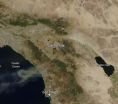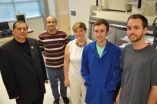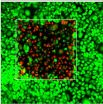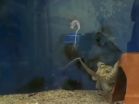(Press-News.org) CLEVELAND -- At the 2014 American Association of Neurological Surgeons Annual Meeting, neurosurgical researchers from University Hospitals (UH) Case Medical Center presented results from a small study looking at deep brain electrode implantation as a possible alternative to the traditional WADA test used prior to epilepsy surgery.
The WADA test is considered the gold standard for identifying the side of the brain for speech dominance. In the WADA test, doctors put one half of a patient's brain to sleep for a few minutes using medication and then have the patient read words and look at pictures. Then the procedure is repeated with the other half of the brain asleep. How well the patient retains the memory and is able to say what she saw, depending on which side of the brain was asleep, allows doctors determine which side is dominant for language and memory. The information is important for determining if surgery can be performed without harm to language and memory functions. (WADA is named for the Japanese physician who first performed it.)
Jonathan Miller, MD, a neurosurgeon, Director of Functional and Restorative Medicine at UH Case Medical Center, and Assistant Professor of Neurosurgery at Case Western Reserve University School of Medicine, and colleagues, tested a potential alternative method, called the "Electric WADA," with patients who received deep brain implants.
With four patients implanted with deep brain electrodes to identify the areas of the brain where their epileptic seizures originated, Dr. Miller was able to stimulate each side of the brain while the patient read words. He found that their speech was halted upon stimulation on the speech dominant side of the brain, but unaffected by stimulation on the non-dominate side. And there were no adverse events of implantation or stimulation.
"Brain mapping using depth electrodes represents a potential alternative to the WADA test in cases where the side of speech dominance is uncertain," said Dr. Miller. "The main advantage for the implantation is for patients who will have electrodes implanted in that location anyway, so that WADA can be avoided, or for small children who cannot cooperate with the traditional WADA."
INFORMATION: END
UH Case Medical Center neurosurgeon uses depth electrodes for speech mapping
Innovative procedure known as the 'Electric WADA'
2014-05-15
ELSE PRESS RELEASES FROM THIS DATE:
Study: Targeted funding can help address inequities in early child care programs
2014-05-15
CORVALLIS, Ore. – The quality of early child care and education programs is influenced both by funding and by the characteristics of the communities in which the programs operate, new research from Oregon State University shows.
The findings indicate that law- and policy-makers may need to consider the demographics of communities when making funding decisions about early childhood programs, said Bridget Hatfield, an assistant professor in OSU's College of Public Health and Human Sciences.
That's especially important now because many states, including Oregon, are adopting ...
Fires in San Diego County blazing
2014-05-15
The single fire that ignited and split into nine separate fires still blazes in Southern California today. Firefighters are hoping for a break today (Thursday, May 15, 2014) but it doesn't look like luck may be on their side. Conditions continue to be bone dry with unseasonal heat (98-106 degrees) and the Santa Ana winds are kicking up and allowing these fires to easy jump fire lines. This particular fire started on Wednesday as a single fire and within a day is now nine separate fires which have burned close to 10,000 acres. These fires are threatening more than just ...
Giant telescope tackles orbit and size of exoplanet
2014-05-15
Using one of the world's largest telescopes, a Lawrence Livermore team and international collaborators have tracked the orbit of a planet at least four times the size of Jupiter.
The scientists were able to identify the orbit of the exoplanet, Beta Pictoris b, which sits 63 light years from our solar system, by using the Gemini Planet Imager's (GPI) next-generation, high-contrast adaptive optics (AO) system. This approach is sometimes referred to as extreme AO.
The Gemini Planet Imager snapped an amazingly clear and bright image of the gas giant Beta Pictoris b after ...
Detailed studies reveal how key cancer-fighting protein is held in check
2014-05-15
St. Jude Children's Research Hospital scientists have mapped the structural details of how p53 attaches to its regulatory protein, called BCL-xL, in the cell. The protein p53 is a key activator of the cell's protective machinery against genetic damage, such as the mutations that drive cancer cells' explosive growth.
The detailed understanding of how these two molecular puzzle pieces fit together will help scientists design drugs that release p53 in cancer cells, triggering their suicide, called apoptosis.
The findings appear in the current online journal Nature Structural ...
Researchers examine intersection of aging, chronic disease
2014-05-15
A new collection of articles appearing in The Journals of Gerontology, Series A: Biological Sciences and Medical Sciences examine how the basic biology of aging drives chronic disease. Together, they highlight the value of the emerging field of geroscience, which uses an integrated approach to the study of diseases and disability associated with growing older.
Geroscience seeks to bridge the divide between studies of aging and studies of chronic disease, with the hope of understanding their complex relationship and pointing the way to novel interventions for disease, ...
Silly Putty material inspires better batteries
2014-05-15
RIVERSIDE, Calif. (http://www.ucr.edu) — Using a material found in Silly Putty and surgical tubing, a group of researchers at the University of California, Riverside Bourns College of Engineering have developed a new way to make lithium-ion batteries that will last three times longer between charges compared to the current industry standard.
The team created silicon dioxide (SiO2) nanotube anodes for lithium-ion batteries and found they had over three times as much energy storage capacity as the carbon-based anodes currently being used. This has significant implications ...
Going beyond the surface
2014-05-15
BUFFALO, N.Y. – Photodynamic therapy (PDT) is an effective treatment for easily accessible tumors such as oral and skin cancer.
But the procedure, which uses lasers to activate special drugs called photosensitizing agents, isn't adept at fighting cancer deep inside the body. Thankfully, that's changing due to new technology that could bring PDT into areas of the body which were previously inaccessible.
Described May 11 in the journal Nature Photonics, the approach involves using near-infrared beams of light that, upon penetrating deep into the body, are converted into ...
How octopuses don't tie themselves in knots
2014-05-15
VIDEO:
An octopus is treating its own freshly amputated arm in a strange and exploratory manner that is not commonly seen with respect to food items. Note the 'startle' response of...
Click here for more information.
An octopus's arms are covered in hundreds of suckers that will stick to just about anything, with one important exception. Those suckers generally won't grab onto the octopus itself; otherwise, the impressively flexible animals would quickly find themselves all tangled ...
First test of pluripotent stem cell therapy in monkeys is a success
2014-05-15
Researchers have shown for the first time in an animal that is more closely related to humans that it is possible to make new bone from stem-cell-like induced pluripotent stem cells (iPSCs) made from an individual animal's own skin cells. The study in monkeys reported in the Cell Press journal Cell Reports on May 15th also shows that there is some risk that those iPSCs could seed tumors, but that unfortunate outcome appears to be less likely than studies in immune-compromised mice would suggest.
"We have been able to design an animal model for testing of pluripotent ...
Mice with MS-like condition walk again after human stem cell treatment
2014-05-15
(SALT LAKE CITY) - Mice severely disabled by a condition similar to multiple sclerosis (MS) were able to walk less than two weeks following treatment with human neural stem cells. The finding, which uncovers potential new avenues for treating MS, will be published online on May 15, 2014, in the journal Stem Cell Reports.
In striking contrast to active, healthy mice, those with an MS-like condition must be fed by hand because they cannot stand long enough to eat and drink on their own. When scientists transplanted human neural stem cells into the MS mice, they expected ...
LAST 30 PRESS RELEASES:
Missed signals: Virginia’s septic strategies overlook critical timing, study warns
Delayed toxicities after CAR T cell therapy for multiple myeloma are connected and potentially preventable
Scientists find cellular key to helping plants survive in saltwater
Medical cannabis program reduces opioid use
Immunotherapy works for sepsis thanks to smart patient selection
Cardiovascular events 1 year after RSV infection in adults
US medical prices and health insurance premiums, 1999-2024
Medical cannabis and opioid receipt among adults with chronic pain
Multichannel 3D-printed bioactive scaffold combined with siRNA delivery for spinal cord injury recovery
Triaptosis—an emerging paradigm in cancer therapeutics
A new paradigm in spectroscopic sensing: The revolutionary leap of SERS-optical waveguide integration and ai-enabled ultra-sensitive detection
Sweet tooth: How blood sugar migration in diabetes affects cavity development
Lowest suicide rate is in December but some in media still promote holiday-suicide myth
Record-breaking cosmic explosion challenges astronomers’ understanding of gamma-ray bursts
Excessive heat harms young children’s development, study suggests
Quanta Books to publish popular math and physics titles by Terence Tao and David Tong
Philanthropic partnerships fund next-generation instruments for mid-sized telescopes
AI offers ‘roadmap’ to plant genetics
Myosin XI-1: A key molecular target for salt-tolerant crops
Pusan National University study highlights the health hazards of ultrafine particles from small home appliances with electric heating coils and brushed DC motors
Global first: New Indigenous-led research initiative to revitalize legal orders
Transforming acoustic waves with a chip
When climate risk hits home, people listen: Study reveals key to engagement with disaster preparedness messaging
Major breakthrough against diabetes thanks to a microbial molecule that disarms inflammation
Silicon chips on the brain: Researchers announce a new generation of brain-computer interface
Getting rest is the best
Towards sustainable organic synthesis – Mechanochemistry replaces lithium with sodium in organic reactions
Wireless device ‘speaks’ to the brain with light
Greenhouse gases to intensify extreme flooding in the Central Himalayas
New study sheds light on Milky Way's mysterious chemical history
[Press-News.org] UH Case Medical Center neurosurgeon uses depth electrodes for speech mappingInnovative procedure known as the 'Electric WADA'





